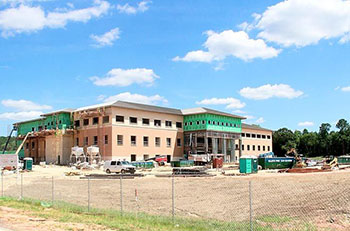Choctaw Health Center Recognized for Green Construction
 PHILADELPHIA, Miss. — Established by the U.S. Green Building Council and verified by the Green Building Certification Institute (GBCI), the LEED Gold designation has been awarded to the Mississippi Band of Choctaw Indians’ Choctaw Health Center (CHC), located in Philadelphia, Miss., for its advancements in green construction.
PHILADELPHIA, Miss. — Established by the U.S. Green Building Council and verified by the Green Building Certification Institute (GBCI), the LEED Gold designation has been awarded to the Mississippi Band of Choctaw Indians’ Choctaw Health Center (CHC), located in Philadelphia, Miss., for its advancements in green construction.
The awarded center achieved its LEED certification for energy use, lighting, water and material use as well as for other sustainable strategies, Choctaw’s press release further stated.
“Buildings are a prime example of how human systems integrate with natural systems,” expressed Rick Fedrizzi, president, CEO and founding chair, U.S. Green Building Council. “The Choctaw Health Center project efficiently uses our natural resources and makes an immediate, positive impact on our planet, which will tremendously benefit future generations to come.”
By using less energy and water, LEED-certified are capable of saving money for families, businesses and taxpayers. Furthermore, LEED-certified buildings aid in the minimization of greenhouse gas emissions while also contributing to healthier living spaces for residents, workers and the larger community.
Additional elements of green design and construction, which led to the CHC’s LEED certification, include:
• Use of low-flow water conserving plumbing fixtures to achieve 38.32 percent water use reduction for the project.
• Use of native plant species and high-efficiency irrigation technology to achieve 53.47 percent reduction of water consumption for irrigation.
• High-efficiency design and systems technology to achieve energy cost savings of 35.55 percent over a base code ASHRAE 90.1-2007 compliant similar building.
• Dedicated areas for collection and storage of recyclables within the building and on site.
• Diversion of over 40 percent of the on-site construction waste from landfills through recycling.
• Over 22 percent of the total building materials were specified and manufactured using recycled materials.
• Over 34 percent of the total building materials include materials and products that were manufactured and extracted within a 500-mile radius of the project site.
• Use of low-emitting materials like adhesives, sealants, paints, flooring and composite wood to provide healthy indoor air quality.
• Use of low-emitting furnishing systems to reduce the quantity of indoor air contaminants that are odorous or harmful and promote the comfort and well-being of installers, staff occupants and patient visitors.
